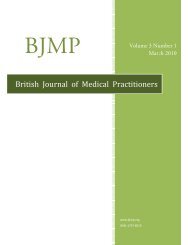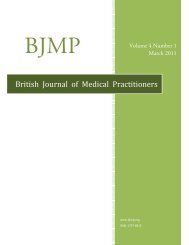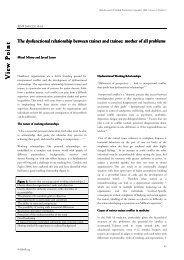R esearch A rticle - British Journal of Medical Practitioners
R esearch A rticle - British Journal of Medical Practitioners
R esearch A rticle - British Journal of Medical Practitioners
Create successful ePaper yourself
Turn your PDF publications into a flip-book with our unique Google optimized e-Paper software.
<strong>British</strong> <strong>Journal</strong> <strong>of</strong> <strong>Medical</strong> <strong>Practitioners</strong>, March 2013, Volume 6, Number 1<br />
BJMP 2013;6(1):a604<br />
Review A<strong>rticle</strong><br />
Recent advances in the management <strong>of</strong> major obstetric haemorrhage<br />
Rajashree Chavan and M Y Latoo<br />
Introduction<br />
Major Obstetric haemorrhage (MOH) remains one <strong>of</strong> the<br />
leading causes <strong>of</strong> maternal mortality & morbidity worldwide. In<br />
the 2003-2005 report <strong>of</strong> the UK Confidential Enquiries into<br />
Maternal Deaths, haemorrhage was the third highest direct<br />
cause <strong>of</strong> maternal death (6.6 deaths/million maternities) with<br />
the rate similar to the previous triennium 1, 2 . Postpartum<br />
haemorrhage (PPH) accounts for the majority <strong>of</strong> these deaths.<br />
This triennium, 2006-2008, unlike in previous reports there has<br />
been a change in the rankings <strong>of</strong> direct deaths by cause. Deaths<br />
from haemorrhage have dropped, to sixth place, following<br />
genital tract sepsis, preeclampsia, thromboembolism, amniotic<br />
fluid embolism and early pregnancy deaths 3 . A well-defined<br />
multidisciplinary approach that aims to act quickly has<br />
probably been the key to successful management <strong>of</strong> MOH. In<br />
the developing world, several countries have maternal mortality<br />
rates in excess <strong>of</strong> 1000 women per 100,000 live births, and<br />
WHO statistics suggests that 25 % <strong>of</strong> maternal deaths are due<br />
to PPH, accounting for more than 100,000 maternal deaths per<br />
year 4 .The blood loss may be notoriously difficult to assess in<br />
obstetric bleeds 5, 6 . Bleeding may sometimes be concealed &<br />
presence <strong>of</strong> amniotic fluid<br />
challenging.<br />
Definition<br />
makes accurate estimation<br />
MOH is variably defined as blood loss from uterus or genital<br />
tract >1500 mls or a decrease in haemoglobin <strong>of</strong> >4 gm/dl or<br />
acute loss requiring transfusion <strong>of</strong> >4 units <strong>of</strong> blood. Blood loss<br />
may be:<br />
1. Antepartum: Haemorrhage after 24th week gestation &<br />
before delivery; for example: placenta praevia, placental<br />
abruption, bleeding from vaginal or cervical lesions.<br />
2. Postpartum: Haemorrhage after delivery<br />
• Primary PPH: Within 24 hours <strong>of</strong> delivery, which is >500<br />
mls following vaginal delivery & > 1000mls following a<br />
caesarean section 7 .<br />
• Secondary PPH: 24 hours to 6 weeks post-delivery; for<br />
example: Uterine atony, retained products <strong>of</strong> conception,<br />
genital tract trauma, uterine inversion, puerperal sepsis,<br />
uterine pathology such as fibroids 8 .<br />
PPH can be minor (500-1000 mls) or major (> 1000 mls).<br />
Major PPH could be divided to moderate (1000-2000 mls) or<br />
severe (>2000 mls).<br />
Causes<br />
Causes <strong>of</strong> PPH may be conveniently remembered using 4 T’s as<br />
a mnemonic:<br />
• Tone(Uterine atony)<br />
• Tissue (retained products)<br />
• Trauma( cervical & genital tract trauma during delivery)<br />
• Thrombosis (coagulation disorder)<br />
Other Risk factors include:-Prolonged labour, multiple<br />
pregnancy, polyhydramnios, large baby, obesity, previous<br />
uterine atony & coagulopathy.<br />
Prevention<br />
The most significant intervention shown to reduce the<br />
incidence <strong>of</strong> PPH is the active management <strong>of</strong> the third stage <strong>of</strong><br />
labour (see below).Other measures to prevent or reduce the<br />
impact <strong>of</strong> MOH include<br />
• Avoidance <strong>of</strong> prolonged labour<br />
• Minimal trauma during assisted vaginal delivery<br />
• Detection & treatment <strong>of</strong> anaemia during pregnancy<br />
• Identification <strong>of</strong> placenta praevia by antenatal ultrasound<br />
examination.<br />
• Where facilities exist, magnetic resonance imaging (MRI)<br />
may be a useful tool and assist in determining whether the<br />
placenta is accreta or percreta. Women with placenta<br />
accreta/percreta are at very high risk <strong>of</strong> major PPH. If<br />
placenta accreta or percreta is diagnosed antenatally, there<br />
should be consultant-led multidisciplinary planning for<br />
delivery 9 .<br />
Active management <strong>of</strong> the third stage<br />
This represents a group <strong>of</strong> interventions including early<br />
clamping <strong>of</strong> the umbilical cord, controlled cord traction for<br />
placental delivery & prophylactic administration <strong>of</strong> uterotonic<br />
at delivery (e.g. oxytocin) 10 . Active management <strong>of</strong> the third<br />
BJMP.org<br />
17







